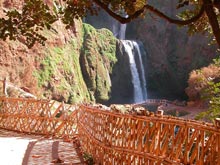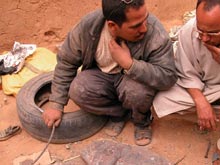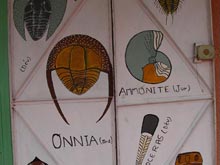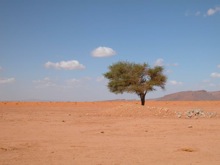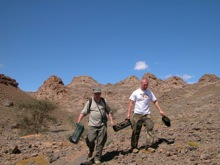Morocco – a fossil factory
In March 2007 we spontaneously set off for our trip through Europe heading to Gibraltar. Two of us left in our trusty Volkswagen T4, three returned, but I won’t get ahead of the story…
Moulay Bousellham
It usually takes us two days to cover the route from Ostrowiec to the Spanish harbour of Algeciras. We sleep in turns and take turns at the steering wheel. 3400 kilometres is a long way after all and if the distance was shorter we would visit Morocco more often. After boarding a ferry and going through the Strait of Gibraltar for another 40 minutes we land in Africa. First is customs clearance and passport control, where we wait for the officers who are never in a hurry. Then we fill out the forms and custom declaration and after 2 hours we can finally enter Morocco. Having carefully planned the route in advance, we drive another 200 km the same day to Moulay Bouselham, a small fishing settlement situated on the Atlantic coast.
We used to pitch up a tent on the camping, but it rained when we came there half a year ago, so we decided to stay at a hotel and we’ve been doing it ever since. There is always a small room with a balcony waiting for us from which a view over a fair-sized lagoon spreads. There are two beds, two lamps, and a bathroom with some happy cockroaches.
From an ordinary person’s point of view there is nothing really interesting going on in Moulay. The only thing this settlement can offer is a walk along the beach, a terribly stinking fish market and short boat trips over the lagoon in order to search for flamingos resting here during their migrations. As the place is not besieged by tourists, you can have a reasonably priced and tasty meal in one of a few small restaurants. As a visitor you have to cope with dirty forks with bent prongs to which potato and yolk leftovers cling, grey wrapping paper serving as napkins and small insects swimming in the tea. If you manage to overcome these obstacles you can enjoy the taste of fried fish, grilled vegetables and seafood (provided that you like them of course).
We were surprised by the fact that the waiter, after taking an order for egg omelette with cheese, takes the bag and rushes to the nearby shop to get the eggs. Similarly with fish. You order it and he runs out from the restaurant just to return in a while with a plastic bag from which fish tails stick out. These observations stopped us from ordering mutton.
Oued Zem and Khouribgha
We leave Moulay Bousleham and head for Oued Zem and Khouribgha. There are huge mine fields in this region where phosphates from circa 65 million year old rocks are extracted. In the local mines fossilised shark teeth and vertebrae, remains of turtles and large sea reptiles (crocodiles and mesosauria) come out in large numbers. A lot of miners acquire fossils which are then sold in Morocco as souvenirs. We espied a piece of crocodile skeleton from the Cretaceous period in one of these „shops”; a specimen which was definitely worth covering thousands of kilometres. After bargaining and negotiating for a long time we manage to buy the specimen. Satisfied, we leave for Beni Melal and make a short stop on the way to see the granite erosion.
Sidi Rahhal
The next leg of our journey leads toward Marrakech. A hill range built up of volcanic rocks – basalts – spreads east of the town. We visit Sidi Rahhal, where local men hew quite long drifts in the rock in order to extract colourful quartz geodes.
Buying anything in Morocco is like a ritual. Before you begin to choose stones, you get to the mine to see under which conditions they are extracted to learn what hard and time-consuming this work is. Then you return to the local tradesman’s house, search numerous boxes and put aside the specimens you find interesting. Later there is a coffee/lunch break and finally you can start bargaining. The first price is so high, sometimes even ridiculous, but in time you can cut it by up to a half. However, it takes a great deal of time, so you usually have to stay there overnight, or for dinner at least.
Going toward Alnif
From Sidi Rahhal through the Tizin Tischka pass and the Atlas Mountains we go towards Amerzgan. We hang around on surrounding hills and river valleys collecting agates, which often reveal either a beautiful colour or an interesting pattern after cutting in two.
The next stop is a small settlement Alnif. We stay there for a couple of days because there is a lot to see in the neighbourhood and our acquaintances from a small restaurant serve tasty meals. Another car with our Polish friends arrives in the evening, so we’ve got a chance to party with them.
Collecting fossils
In the morning we head for surrounding hills. The ordovician rocks occur on the Jebel Tiskoine, in which you can find numerous fossilised trilobites – the extinct sea arthropodes. We split into small groups and each one starts exploring on their own. After a while it turns out that there is a large number of fossilised trilobite shells. Unfortunately, they crumble into small pieces during extraction from the rock. We learn the lesson that it’s worthwhile to have glue on ourselves. Undaunted by our failure, Jarek and I take down quite a big rock block with the brachiopod valves (shells).
Tassmant
A new day begins. As it’s fairly long we decide to travel several kilometres towards the small village of Tassamant. The village is situated among greenish hills built of called mudstones which easily break into small plates. Mudstones are rocks developed on the sea bottom around half a billion years ago. The local population not only breeds goats, grows cereal or almonds but also extracts Cambrian fossils and it’s the latter that interests us most. As we aren’t here for the first time we are welcomed and entertained. Tagine (a dish made of potatoes, vegetables and mutton), olive oil, fig jam, home-made bread and oranges are served. After a meal and a few glasses of Moroccan tea we are allowed to see the fossils. Eventually, we leave the house with several hundred dirhams less in our pockets, but with a small parcel containing trilobites. We are coming back to our ”base” in high spirits. In the morning we decide that the other group sets off the next day but Marian stays with us – and this is why three of us return to Poland.
Todra Gorge
The next day we decide to take the new road being built through the mountains from Alnif to Tinrir. There is one of the well-known tourist attractions in Morocco near Tinrir, namely the Todra Gorge, where a road cuts into several hundred-metre-high rock faces.
Our travel is rather comfortable, even though the asphalt hasn’t yet been laid. We even manage to shift into third gear at times. The almost 50 kilometre route picturesquely meanders through the mountains. However, on our way back we get lost and drive into alluvial sand, where the car promptly gets stuck. If it hadn’t been for the help of roadwork workers, we would most likely have stayed there until the evening trying to dig the car out. A large lorry tows us out of the sand without any significant effort. We return the favour with clean t-shirts and arrive at Alnif in the evening. Our host shows us around and we visit Medina – the oldest part of the town. Then we go from one workshop to another, watching craftsmen at work. No trip organised by a travel agency can give you such an insight into the country and people living there, so travelling like this is definitely worthwhile.
El Bega
After leaving Alnif we head for the Algerian border. We reach El Bega – a small settlement situated between the sandstone hills. There are numerous mineshafts and drifts dug in the rocks. This is where the local miners search for dinosaur bones and teeth of the Cretaceous period. Our search is fruitless, so we get back to the village. Quite a big group of locals gathered there in the meantime in hopes of selling us their finds. Besides the numerous crocodile teeth and small teeth of flying reptiles, we also come across, among others, pterosaur and dinosaur bones, their teeth and remains of fishes. Sadly, locals destroy a lot of valuable paleontological specimens during the wasteful exploitation of the sources. Primitive methods of extracting the specimens don’t allow the uncovering of, say, the complete skeleton, but instead, only the pieces of bones or teeth are torn out from the ground.
Erfoud region
There is a place near Erfoud referred to by geologists as the Kess Kess formation. Over an area of several square kilometres a formation resembling huge cones spreads. These are devonian mud mounds - an equivalent of the contemporary coral reef. We were trying to get there but after a previous sand storm and having in mind the troubles near Alnif we finally abandon the idea of going through the sand. Instead, we set off in bright sun toward „our mounds”. We return in excellent spirits, carrying a box full of fossilised corals and the backpacks filled with bivalves, brahiopods, goniatites and trilobites.
To end the day on the high note we decide to visit another local attraction, namely the public baths, to the joy of my fellow-travellers. After that we go for an overnight stay with my long-time friend Mohamed Mediki whom I got to know during my first travels to Morocco.
We spend another day in Erfoud hanging around and drifting from one shop and fossil preparatorium to another. Then we head north towards Fes and this is where our travel comes to an end...
Translation from the Polish: Paweł Jankowski Proofreading: Will Harper








